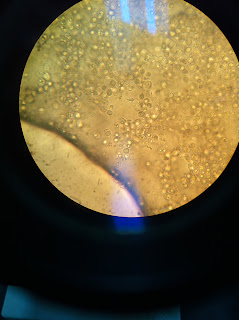Matric No.
: 111372
Lab 1:
Principles and use of microscope
Introduction
1.1 Setting
up and using the microscope
In order to
be seen, microorganisms need to be magnified. Despite advances in other area of
microscopy (for example, the electron microscope), the light microscope is
still the instrument most frequently used for viewing microorganisms.
1.2
Examination of cells
Because of
their extreme minuteness, bacteria are not generally studied with the low-power
or high power-power dry objectives. Instead they are stained and observed with
the oil immersion objective.
The wet
mount methods enable you to study the sizes and shapes of living microorganisms
(drying or staining microorganisms distort them). It also enables you to
determine if cells are motile. The wet mount method is quick and easy, and does
not require special equipment.
Objective
1.1 Setting
up and using the microscope
Learn to
use a simple bright-field microscope correctly
1.2
Examination of cells
a) To
provide an experience in the use of microscope.
b) To
illustrate the diversity of cells and microorganisms.
Results : 1.1)
Stained Cells
Typical
Bacillus ( 40x Magnification)
Typical Bacillus ( 100x Magnification)
Typical Bacillus ( 400x Magnification)
Typical Bacillus ( 1000x Magnification)
Discussions:
By using
the magnification of 40x, 100x, 400x, 1000x, we are able to see a very clear
image of the Typical Bacillus. The specimen is observed from the lowest 40x
magnification to the highest magnification which is 100x. We can see clearly
the morphology of typical bacillus.
The colony
morphology of Typical Bacillus:
a)
Colour: Red
b)
Shape: irregular shape
c)
Size:
Punctiform
d)
Texture:
Moist
e)
Surface:
Smooth and shiny
Results: 1.2) Wet mount
Lactobacillus fementum (1000x Macnification)
Discussions:
The wet mount method was used to
determine size and shape of living microorganisms. We need to use the aseptic
technique which is the flame sterilization to sterilize the opening of vessel
and inoculating loops. This technique is used to avoid contamination of the sample.
Besides that, oil immersion is used to view individual cell or the details of
the striations of muscle. It is nearly impossible to view living, motile
protest at a magnification of 1000x, except for the very small and slow one.
The
morphology of Lactobacillus fermentum:
f)
Colour:
Grey
g)
Shape:
Rod shape
h)
Size:
Punctiform
i)
Texture:
Moist
j)
Surface:
Shiny and smooth
The colony
morphology of Saccharomyces cerevisiae:
a)
Colour:
Brownish yellow
b)
Shape:
Circular
d)
Texture:
Moist
e)
Surface:
Rough, dull, wrinkled
Conclusions:
1.1 Setting
up and using the microscope
In conclusion, we can
clearly observed the image of the specimen by using 40x magnification. For the
1000x magnification, a smaller specimen will get a clearer view.
1.2
Examination of cells
In conclusion, a cleary image of cells
can be seen clearly under 1000x magnification with the aid of oil immersion.
References:
~David B. Jansma, REGULATlON
AND VARlATlON OF SUBUNITS OF RNA POLYMERASE II IN SACCHAROMYCES CEREVISIAE
~ Golden,
David M.; Jay, James M.; Martin J. Loessner (2005). Modern food microbiology. Berlin: Springer. p. 179
~Kandler O., Stetter K., Kohl R. 1980. Lactobacillus reuteri sp. nov. a new species of heterofermentative
lactobacilli. Zbl. Bakt. Hyg. Abt. Orig. C1:264-269
~http://www.connecticutvalleybiological.com/bacteria-typical-bacillus-c-1379_1384.html






No comments:
Post a Comment